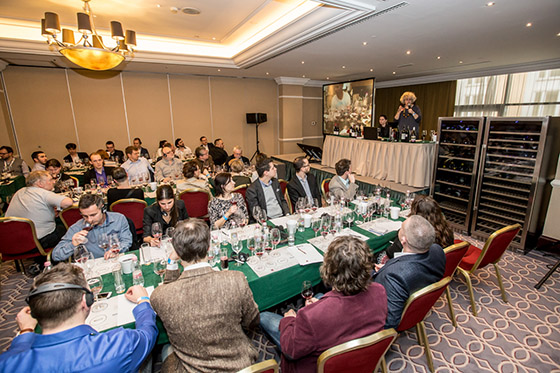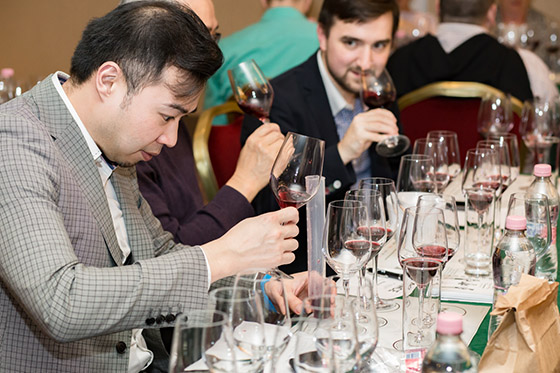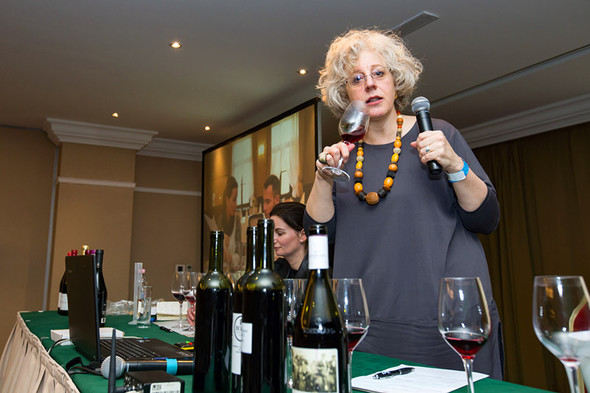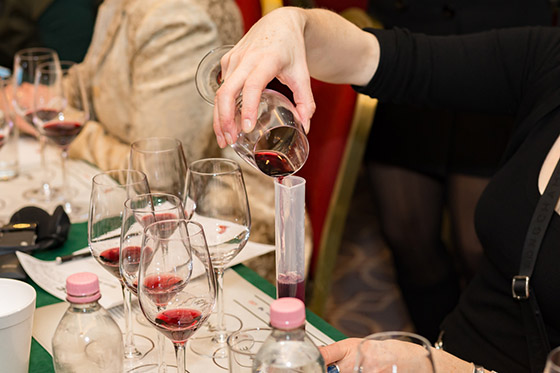I say ‘workshop’ rather than ‘masterclass’, because this was a very hands-on event. We had already had a trial run in November 2016 with a blending exercise that brought out intensity, passion and competitiveness amongst us all as we discussed how to blend a bikavér which summed up the elegant epitome of a Szekszárdi bikavér?
The idea behind the workshop was to introduce participants to different bikavérs within the Szekszárdi style, which had been selected in a blind tasting for showing typicity. We then tasted the five separate components. Kékfrankos, Kadarka, Cabernet Sauvignon, Cabernet Franc and Merlot, selected for showing typical character in the region and without any overt oak character. The percentages allowed by the appellation were explained and we then handed over to the participants to blend their ideal bikavér using the five ingredients.

Csilla and I walked around talking to everyone to see how they were proceeding and answering questions while winemakers Csaba Sebestyén and Péter Vida helped out on two tables with the blending.
Once again we could see the intensity with which everyone tried their blending and the pride on their faces when they arrived at a blend they were happy with. Our biggest problem was that we could have easily used a second hour to taste all of the blends and discuss the different bikavérs, so many apologies to all those who created a masterpiece which we were unable to try. Participants also felt they would have liked more time to discuss their blends and decide on the best proportions. VinCE take note – next year we will want a two hour slot!
What did come through from my tour of the blenders, was the personal preferences, the ‘house style’ of the different groups, whether more Kadarka, Bordeaux or Kékfrankos.
At the end I had to choose one person to present their blend – a difficult choice. I decided to invite Dez O’Connell, bar and drinks consultant at the Brody House Studio as well as a cocktail maker because blending a wine is not so very dissimilar to making a cocktail, but cocktail makers have refined the art of understanding the breakdown of components in blending and the ability to explain how the final blend is achieved. While many of us trust to our instincts (which may or may not be accurate) Dez was able to put into words how he created his blend.
I am quoting him here in full because I think it is interesting for winelovers to see how interesting cocktail making can be when understanding wine.
Some similarities in the producing of tasty cocktails and the blending of the Bikavér... pay attention to the classics. You have to understand the structure of the classics and how they achieve balance before you can even think about creating a new cocktail or even riffing on a classic to produce what we call a ‘Twist’ in the bar world. So, when Elizabeth and Csilla were quite insistent on the basic recipe that would define the essence of the appellation I didn't want to steer too far off of it.
Likewise, we were warned of the cheekiness of the Kadarka and how it can dominate despite tasting so light. A bit like floral spirits or liqueurs in cocktails, the delicate floral character of Kadarka can overwhelm the blend and reduce the structure. So I kept the Kadarka right down.
Another similarity is the balance of the various ingredients to compliment and/or contrast each other. As the Kékfrankos which is vital to the blend was full of cherries and violets, driven with fresh acidity I wanted a counterbalance of sweeter fruits and more masculine notes (probably found in the Cabernet Sauvignon which was quite prominent in my blend). But with those big tannins and bright acidity I also needed to add some appealing smooth notes and the Merlot really helped that with its medium sweet roundness.
Finally, good cocktails have the balance of sweet, sour, strong and weak and it's clear which of the grape varieties we used fit those categories. And when twisting a classic it is often helpful to include a 5th dimension in the form of a spice, herb or savoury note. The Cabernet Franc brings this I think with it's different tannins, smoke and vanillans.
I managed to track down some other participants who were happy to talk to me about the workshop.
Sue Tolson, translator, editor and wine writer with WineSofa ‘found it helpful to better understand what each variety gives to the blend and how just adjusting the % of one variety, e.g. Kadarka, even quite minimally can make a huge difference to the balance of the wine. It makes you understand how key the winemaker's role is in the crafting of a good Bikavér. It was also a good chance to reflect on how the different styles of Bikavér - rounder, riper, tannic style and the fresher style might be composed. It also made me appreciate how difficult it is to define the essence of a region and its main blend when such wines can be so different each time.’
Zoltán Szövérdfi-Szép, who runs the Rovinhud Wine Festival in Timisoara, Romania every November, really enjoyed the workshop because it was the first time he had actually done any wine blending. ‘It was so much fun!’ he enthused. ‘As well as being interesting and informative.’ By the end he felt he understood the rules and styles of the wine.
Piroska Koltai of Wine a'More Travel who blended her wine with Zoltán, Péter Vida and two other participants enjoyed the camaraderie and sociability of working with others at her table. As far as the bikavér was concerned, she found that workshop ‘definitely helped [her] to understand the essence of blending … Just like cooking: ‘maybe a bit more salt or sugar?’ ‘a sip of aceto balsamico?’ etc. It's a fantastic game of senses, learn about smell and taste.’ It certainly removed the mystery from the blending process and showed that ‘choosing the right proportion is a very serious decision, one that determines the image of the wines of a winery’
Gyula Weeber, with his Taiwanese colleagues (who sell and promote wine in Taiwan) ‘really enjoyed the bikavér masterclass, it was great to taste the ingredients separately and it was interesting to see how different nationalities made their own mix.’ Gyula found that he tended towards a Kadarka-heavy blend while the Taiwanese, however, greatly preferred a strong Bordeaux blend character and were keen to create a bigger, bolder and darker wine and would have liked more oak.

Jakub Pasternak from the Ale Wino restaurant in Warsaw which specialises in wines from more unexplored regions including Hungary, Slovenia, Greece and Poland or wines from well-known regions but less known varieties, felt the ‘masterclass helped [him] significantly to understand essential differences between Egri and Szekszárdi Bikavér. The most surprising thing was an idea of live, tutored blending wines with participants, that was great! I am pretty sure that, organizing masterclass in this scheme is much more interesting and eye-opening, than a regular lecture. Broadly speaking, I think, that topic of blending, especially during wine courses, is not discussed or considered relevant. Only tastings or particularly events like yours could improve level of awareness.’
My own comments, raised other questions. Possibly because I am not very precise when cooking. I did wonder how accurate were our trial blends in the test tube? As Sue pointed out, a slight shift in the percentage could alter the blend, so it would be good to double check the trial blends. I also forgot to ask – what if the perfect blend is selected and there isn’t quite enough of one ingredient….? How would the blend develop once aged in oak? Which type of oak, size of barrel, age of barrel? The influence of the terroir on each variety? The vintage?
OK – maybe I am getting carried away… but the endless permutations with which the winemaker must play to create a house style, a wine which fits the style of the appellation, the best wine within the vintage parameters... all added to the excitement of learning how to blend a wine.
The blends
- Sue’s blend: 60% Kékfrankos, 6% Kadarka, 15% Merlot, 15% Cabernet Franc, 4% Cabernet Sauvignon
- Zoltán’s blend: 50% Kekfrankos, 10% Kadarka, 25% Merlot, 15% Cabernet Franc. Despite being fascinated by the warning that too much Kadarka could upset the blend, and wanting to try a blend with 45% Kadarka, he stuck to the rules.
- Zoltán, Piroska, Péter Vida team’s blend: 60% Kékfrankos, 10% Kadarka, 15% Merlot, 15% Cab Franc
- The Taiwanese blend: 45% Kékfrankos 5% Kadarka 10% Cabernet Franc 20% Merlot, 20% Cabernet Sauvignon
- Gyula Weeber: 45% Kékfrankos 12% Kadarka 8% Merlot 13% Cabernet Sauvignon 18% Cabernet Franc
Pasternak commented that written guidelines on the appellation and blending quantities would have been useful and possibly to allow for participants to write down the blends they tried with tasting notes. Not everyone kept their prized recipe – so this would be a good idea.
Photos by Tamás Totisz / VinCE







